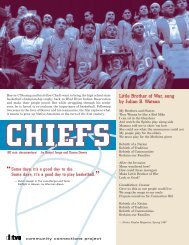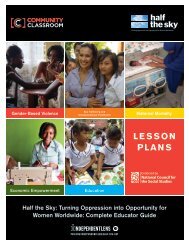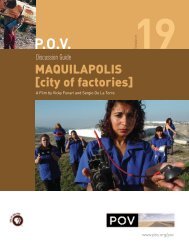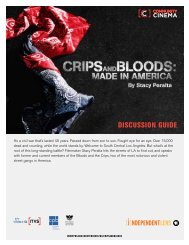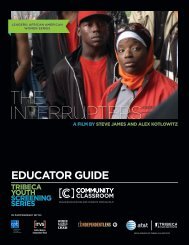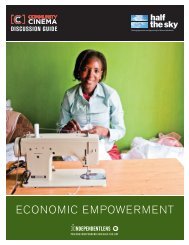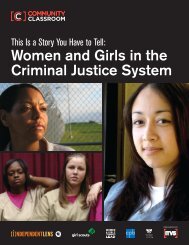Lesson Plan: Examine Labor Practices in the Garment Industry - PBS
Lesson Plan: Examine Labor Practices in the Garment Industry - PBS
Lesson Plan: Examine Labor Practices in the Garment Industry - PBS
- No tags were found...
Create successful ePaper yourself
Turn your PDF publications into a flip-book with our unique Google optimized e-Paper software.
<strong>Lesson</strong> <strong>Plan</strong>: <strong>Exam<strong>in</strong>e</strong> <strong>Labor</strong> <strong>Practices</strong><strong>in</strong> <strong>the</strong> <strong>Garment</strong> <strong>Industry</strong>OVERVIEW:This lesson plan is designed to be used <strong>in</strong> conjunction with <strong>the</strong> film Made <strong>in</strong> L.A., a filmthat follows <strong>the</strong> struggle of three Lat<strong>in</strong>a immigrants work<strong>in</strong>g for fair labor conditions <strong>in</strong>Los Angeles’s garment factories. Note: This film has bil<strong>in</strong>gual subtitles throughout and isfully accessible to English and Spanish speakers. This lesson compares currentconditions <strong>in</strong> <strong>the</strong> garment <strong>in</strong>dustry with those at <strong>the</strong> turn of <strong>the</strong> 20 th century.Note: The filmmaker’s version of Made <strong>in</strong> L.A. conta<strong>in</strong>s one <strong>in</strong>cidence of strongprofanity about 12 m<strong>in</strong>utes <strong>in</strong>to <strong>the</strong> film that may be <strong>in</strong>appropriate for classroomuse. To avoid such content, be sure to record <strong>the</strong> <strong>PBS</strong> broadcast version off-air orrequest <strong>the</strong> “broadcast version” of <strong>the</strong> film from <strong>the</strong> P.O.V. lend<strong>in</strong>g library.P.O.V. documentaries can be recorded off-air and used for educational purposes for upto one year from <strong>the</strong> <strong>in</strong>itial broadcast. In addition, P.O.V. offers a lend<strong>in</strong>g library of DVDsand VHS tapes that you can borrow anytime dur<strong>in</strong>g <strong>the</strong> school year — FOR FREE!OBJECTIVES:By <strong>the</strong> end of this lesson, students will:• Work <strong>in</strong> cooperative learn<strong>in</strong>g groups to study various topics related to fair laborpractices <strong>in</strong> <strong>the</strong> garment <strong>in</strong>dustry, both <strong>in</strong> historic and modern times.• Take a quiz to measure <strong>the</strong>ir knowledge about <strong>the</strong> topics studied.GRADE LEVELS: 6-12SUBJECTS: Current Events, U.S. History, Civics, Economics, GeographyMATERIALS NEEDED:• Equipment for show<strong>in</strong>g onl<strong>in</strong>e video clips to <strong>the</strong> class (method varies by school)• Computers with access to <strong>the</strong> Internet• Handout: <strong>Garment</strong> <strong>Industry</strong> <strong>Labor</strong> Quiz (PDF file)ESTIMATED TIME NEEDED: One 50-m<strong>in</strong>ute classSUGGESTED CLIPS:Clip 1: María (Length: 02:05)The clip beg<strong>in</strong>s just after <strong>the</strong> film’s title at 02:05 with <strong>the</strong> shot of <strong>the</strong> exterior of María’shome. It ends at 06:20 with a close-up of a sp<strong>in</strong>n<strong>in</strong>g sew<strong>in</strong>g mach<strong>in</strong>e wheel.Clip 2: Pyramid of Power (Length: 01:02)The clip beg<strong>in</strong>s at 55:45 with Lupe say<strong>in</strong>g, “I built a pyramid of power…” It ends at 56:47with “…really, we are very powerful.”Clip 3: Who Is Responsible? (Length: 01:19)
The clip beg<strong>in</strong>s at 20:51 with “Lat<strong>in</strong>o workers announce a lawsuit aga<strong>in</strong>st a garmentcompany…” It ends at 22:10 with “…have an <strong>in</strong>credible impact on <strong>the</strong> <strong>in</strong>dustry as awhole.”Clip 4: Modern Sweatshop (Length: 03:02)The clip beg<strong>in</strong>s at 15:38 with “So we want to hear your problems.” It ends at 18:40 with“So we all decided to start <strong>the</strong> lawsuit aga<strong>in</strong>st Forever 21.”Clip 5: Lupe visits Ellis Island (Length: 01:08)The clip beg<strong>in</strong>s at 38:50 with a shot of <strong>the</strong> Statue of Liberty. It ends at 39:58 with aclose-up shot of a photo from <strong>the</strong> Ellis Island Museum of Immigration.BACKGROUND:In 2001, garment workers from different factories <strong>in</strong> Los Angeles jo<strong>in</strong>ed forces with <strong>the</strong><strong>Garment</strong> Worker Center to file wage claims aga<strong>in</strong>st retailer Forever 21, whosubcontracted with manufacturers to produce <strong>in</strong>ventory for its retail shops. Forever 21said it wasn’t responsible for <strong>the</strong> workers’ compla<strong>in</strong>ts because <strong>the</strong> workers wereemployees of <strong>the</strong> subcontractors, and not Forever 21. Through unity and persistence,<strong>the</strong> workers were able to eventually negotiate a labor settlement with Forever 21 thatimproved labor conditions.Such struggles for better work<strong>in</strong>g conditions are not new <strong>in</strong> <strong>the</strong> United States. The term“sweatshop” was co<strong>in</strong>ed <strong>in</strong> <strong>the</strong> late 1800s to describe factories with poor work<strong>in</strong>gconditions, low wages, long hours and <strong>the</strong> supervisor’s arbitrary power over <strong>the</strong> workers.With <strong>the</strong> help of legislation and union organiz<strong>in</strong>g, work<strong>in</strong>g conditions <strong>in</strong> <strong>the</strong> garment<strong>in</strong>dustry have gradually improved. Sweatshop conditions cont<strong>in</strong>ue to exist <strong>in</strong> many U.S.factories, however, <strong>in</strong>dicat<strong>in</strong>g that <strong>the</strong>re is still progress to be made.ACTIVITY:Explore past and present labor issues <strong>in</strong> <strong>the</strong> garment <strong>in</strong>dustry by conduct<strong>in</strong>g <strong>the</strong>follow<strong>in</strong>g Jigsaw activity:1. Divide <strong>the</strong> class <strong>in</strong>to “Home” groups of five students each. Expla<strong>in</strong> that each group isgo<strong>in</strong>g to be explor<strong>in</strong>g past and current struggles for fair work<strong>in</strong>g conditions <strong>in</strong> <strong>the</strong>garment <strong>in</strong>dustry. Each member of a Home group will become an “Expert” on a specifictopic and will <strong>the</strong>n be responsible for teach<strong>in</strong>g <strong>the</strong> members of his or her Home groupabout that topic. At <strong>the</strong> end of <strong>the</strong> activity, students will take a quiz on ALL of <strong>the</strong> topics,so it is important for each Expert to do a good job of both learn<strong>in</strong>g <strong>the</strong> material andteach<strong>in</strong>g it to <strong>the</strong> members of his or her Home group.2. Next, have a representative from each Home group form temporary Expert groupscomposed of o<strong>the</strong>rs assigned to <strong>the</strong> same topic. Expert groups should study <strong>the</strong> subjectsbelow, discuss <strong>the</strong> ma<strong>in</strong> po<strong>in</strong>ts and guid<strong>in</strong>g questions, and <strong>the</strong>n practice how <strong>the</strong>y willteach <strong>the</strong>ir “Home” group about <strong>the</strong>ir assigned topic.Expert Group 1Topic: What Is a Sweatshop?Resource: Lower East Side Tenement Museum: Lev<strong>in</strong>e Apartmenthttp://www.tenement.org/Virtual_Tour/vt_lev<strong>in</strong>e.htmlGuid<strong>in</strong>g Questions: Who were <strong>the</strong> Lev<strong>in</strong>es and why did <strong>the</strong>y open a garment shop <strong>in</strong><strong>the</strong>ir home? What are <strong>the</strong> characteristics commonly attributed to sweatshops? Why
would <strong>the</strong> Lev<strong>in</strong>es’ shop likely have qualified as a sweatshop? What ultimately spelled<strong>the</strong> end of apartment-based garment factories <strong>in</strong> New York at <strong>the</strong> end of <strong>the</strong> 18 thcentury?Expert Group 2Topic: Worker Strikes Before 1911Resource: Cornell University Onl<strong>in</strong>e Exhibit: The Triangle Factory Firehttp://www.ilr.cornell.edu/trianglefire/Eleanor Roosevelt National Historic Sitehttp://www.nps.gov/archive/elro/glossary/ilgwu.htmSee <strong>the</strong> section “Sweatshops and Strikes Before 1911”, Guid<strong>in</strong>g Questions: What type ofworker is often will<strong>in</strong>g to work <strong>in</strong> sweatshop labor conditions? What important ga<strong>in</strong>s did“The Upris<strong>in</strong>g” achieve?Expert Group 3Topic: Triangle Factory FireResource: Cornell University Onl<strong>in</strong>e Exhibit: The Triangle Factory Firehttp://www.ilr.cornell.edu/trianglefire/See <strong>the</strong> sections “Mourn<strong>in</strong>g and Protest,” and “Investigation, Trial, and Reform,” andFire!Guid<strong>in</strong>g Questions: What factors led to <strong>the</strong> tragic deaths <strong>in</strong> <strong>the</strong> Triangle Factory fire?What happened as a result of this fire?Expert Group 4Topic: The <strong>Garment</strong> <strong>Industry</strong> <strong>in</strong> Modern TimesResources: “María” and “Pyramid of Power” video clips from Made <strong>in</strong> L.A.The <strong>Garment</strong> Worker Center article, “The Fight Aga<strong>in</strong>st Forever 21: Low-WageImmigrant Worker Organiz<strong>in</strong>g for Fairness and Dignity”http://www.garmentworkercenter.org/media/f21/Campaign_Messag<strong>in</strong>g_on_Forever_21.pdf (PDF file)Guid<strong>in</strong>g Questions: What have modern work<strong>in</strong>g conditions been like <strong>in</strong> many of LosAngeles’s garment factories? Why do people like María tolerate such conditions? Whatk<strong>in</strong>d of power do factory workers have when <strong>the</strong>y organize <strong>the</strong>mselves?Expert Group 5Topic: Systemic Issues Affect<strong>in</strong>g Worker ConditionsResources: Filmmaker Interview (pbs.org/pov/pov2007/made<strong>in</strong>la/beh<strong>in</strong>d.html) “Who IsResponsible?” and “Modern Sweatshop” video clips from Made <strong>in</strong> L.A.Guid<strong>in</strong>g Questions: Why didn’t <strong>the</strong> retailer Forever 21 believe that <strong>the</strong>y were responsiblefor <strong>the</strong> workers’ compla<strong>in</strong>ts about unfair work<strong>in</strong>g conditions? How can low price po<strong>in</strong>tsset by retailers affect <strong>the</strong> wages of those who manufacture <strong>the</strong> product?3. Give students about 20 m<strong>in</strong>utes to work <strong>in</strong> <strong>the</strong>ir Expert groups. Then, have eachExpert return to his or her Home group and teach <strong>the</strong> members about <strong>the</strong> topic.Encourage group members to ask questions for clarification.4. At <strong>the</strong> end of <strong>the</strong> activity, use <strong>the</strong> quiz <strong>in</strong> <strong>the</strong> “Assessment Suggestions” section (orcreate one of your own) to f<strong>in</strong>d out what students have learned.ASSESSMENT SUGGESTIONSStudents can be assessed on:
• Their participation <strong>in</strong> <strong>the</strong> Home and Expert groups,• Their scores on <strong>the</strong> provided quiz for this activity.• Answer Key: [1) B; 2) A; 3) D; 4) C; 5) D; 6) C; 7) C; 8) A; 9) B; 10) C.]EXTENSIONS & ADAPTATIONS• Watch <strong>the</strong> film, Made <strong>in</strong> L.A. <strong>in</strong> its entirety. Then, explore one or more of <strong>the</strong>follow<strong>in</strong>g topics <strong>in</strong> an open classroom discussion:o How did Lupe, María, and Maura change over <strong>the</strong> course of <strong>the</strong> Forever21 campaign? How did <strong>the</strong>se changes impact <strong>the</strong>ir personal lives andoutlooks for <strong>the</strong> future?o Create a chart that shows <strong>the</strong> strategies and outcomes of <strong>the</strong> <strong>Garment</strong>Worker Center’s Forever 21 campaign. What were <strong>the</strong> risks of <strong>the</strong>campaign? Why do students th<strong>in</strong>k <strong>the</strong> workers would speak out despite<strong>the</strong>se risks? Why was <strong>the</strong> campaign ultimately successful? The FilmSynopsis on <strong>the</strong> P.O.V. website summarizes this campaign, as do <strong>the</strong><strong>Garment</strong> Worker Center’s archived documents on <strong>the</strong> Forever 21Campaign (http://www.garmentworkercenter.org/forever21.php).o Consider <strong>the</strong> economic struggles and personal sacrifices of Lupe, María,and Maura as <strong>the</strong>y work to earn a liv<strong>in</strong>g for <strong>the</strong>mselves and/or <strong>the</strong>irfamilies. Please see <strong>the</strong> Wag<strong>in</strong>g a Liv<strong>in</strong>g <strong>Lesson</strong> <strong>Plan</strong> for more ideas:http://www.pbs.org/pov/pov2006/wag<strong>in</strong>galiv<strong>in</strong>g/for.html• Read what four activists on today’s front l<strong>in</strong>es of immigration and sweatshopreform have to say about Made <strong>in</strong> L.A. What strategies did each of <strong>the</strong>se activistsuse to br<strong>in</strong>g about positive social change? How do <strong>the</strong>ir experiences and th<strong>in</strong>k<strong>in</strong>gcompare with those of Lupe, Maria, and Maura? What can students learn from<strong>the</strong>se activists to help <strong>the</strong>m address issues <strong>in</strong> your community? Bra<strong>in</strong>storm withstudents some issues <strong>the</strong>y see <strong>in</strong> your community and create a classroom actionplan based on <strong>the</strong>ir research and comments.• Increase students’ knowledge of workers’ movements <strong>in</strong> <strong>the</strong> United States byhav<strong>in</strong>g <strong>the</strong>m listen to P.O.V.’s Wag<strong>in</strong>g a Liv<strong>in</strong>g podcast featur<strong>in</strong>g AmyGoodman’s conversation with Howard Z<strong>in</strong>n, author of A People’s History of <strong>the</strong>United States. Visit:http://www-tc.pbs.org/pov/rss/media/pov_wag<strong>in</strong>galiv<strong>in</strong>g_z<strong>in</strong>n.mp3.A transcript of <strong>the</strong> conversation is also available at:http://www.pbs.org/pov/pov2006/wag<strong>in</strong>galiv<strong>in</strong>g/special_goodman_z<strong>in</strong>n.htmlAsk students to research workers’ movements <strong>in</strong> foreign countries andcompare/contrast <strong>the</strong>ir f<strong>in</strong>d<strong>in</strong>gs with Howard Z<strong>in</strong>n’s comments.• Check out o<strong>the</strong>r P.O.V. films that address immigration and/or labor <strong>the</strong>mes likethose raised <strong>in</strong> Made <strong>in</strong> L.A: Maquilapolis, Wag<strong>in</strong>g a Liv<strong>in</strong>g, Farm<strong>in</strong>gville,Discover<strong>in</strong>g Dom<strong>in</strong>ga and The Sixth Section.• Have students go through <strong>the</strong>ir cloth<strong>in</strong>g at home and make a list of <strong>the</strong> countrieswhere <strong>the</strong>ir clo<strong>the</strong>s were produced. F<strong>in</strong>d <strong>the</strong>se countries on a world map.Discuss <strong>the</strong> pros and cons of produc<strong>in</strong>g cloth<strong>in</strong>g <strong>in</strong> <strong>the</strong>se different countries forconsumers, manufacturers and workers. How do consumer choices <strong>in</strong>fluencehow companies do bus<strong>in</strong>ess? Visit Co-Op America’s Responsible Shopperwebsite (http://coopamerica.org/programs/rs/companies.cfm#cloth<strong>in</strong>g) to
see reports on how well popular cloth<strong>in</strong>g companies address <strong>the</strong> rights ofworkers <strong>in</strong> <strong>the</strong>ir supply cha<strong>in</strong>s.• Illustrate <strong>the</strong> concept of “piecework” for students by tak<strong>in</strong>g an old article ofcloth<strong>in</strong>g, such as a T-shirt or a simple skirt, and cutt<strong>in</strong>g along its seams toseparate it <strong>in</strong>to its <strong>in</strong>dividual pieces. Or take a sew<strong>in</strong>g pattern and lay out eachpart for students to see. Describe (or have someone experienced <strong>in</strong> sew<strong>in</strong>g come<strong>in</strong> to expla<strong>in</strong>) briefly how cloth<strong>in</strong>g is constructed. Tell students that workers <strong>in</strong>garment factories are sometimes paid a piecework rate for each piece of cloth<strong>in</strong>gproduced, or for each part of a garment that <strong>the</strong>y complete <strong>in</strong> an assembly l<strong>in</strong>e.Expla<strong>in</strong> that unscrupulous factory managers would try to m<strong>in</strong>imize labor costs byswitch<strong>in</strong>g fast workers to an hourly rate and pay<strong>in</strong>g slower workers by <strong>the</strong> piece.RESOURCES:The Jigsaw Classroom: A Cooperative Learn<strong>in</strong>g Techniquehttp://www.jigsaw.orgThis resource provides tips on successfully implement<strong>in</strong>g a jigsaw activity and <strong>in</strong>cludesarticles and books related to <strong>the</strong> technique.STANDARDS:These standards are drawn from "Content Knowledge," a compilation of contentstandards and benchmarks for K-12 curriculum by McRel (Mid-cont<strong>in</strong>ent Research forEducation and Learn<strong>in</strong>g) at http://www.mcrel.org/standards-benchmarks/.Behavioral StudiesStandard 4: Understands conflict, cooperation and <strong>in</strong>terdependence among <strong>in</strong>dividuals,groups and <strong>in</strong>stitutions.CivicsStandard 3: Understands <strong>the</strong> sources, purposes and functions of law and <strong>the</strong> importanceof <strong>the</strong> rule of law for <strong>the</strong> protection of <strong>in</strong>dividual rights and <strong>the</strong> common good.Standard 13: Understands <strong>the</strong> character of American political and social conflict andfactors that tend to prevent or lower its <strong>in</strong>tensity.Standard 25: Understands issues regard<strong>in</strong>g personal, political and economic rights.Standard 28: Understands how participation <strong>in</strong> civic and political life can help citizensatta<strong>in</strong> <strong>in</strong>dividual and public goals.EconomicsStandard 2: Understands characteristics of different economic systems, economic<strong>in</strong>stitutions and economic <strong>in</strong>centives.Standard 3: Understands <strong>the</strong> concept of prices and <strong>the</strong> <strong>in</strong>teraction of supply and demand<strong>in</strong> a market economy.Standard 5: Understands unemployment, <strong>in</strong>come, and <strong>in</strong>come distribution <strong>in</strong> a marketeconomy.
GeographyStandard 11: Understands <strong>the</strong> patterns and networks of <strong>in</strong>terdependence on Earth’ssurface.Language ArtsStandard 4: Ga<strong>the</strong>rs and uses <strong>in</strong>formation for research purposes.Standard 9: Uses view<strong>in</strong>g skills and strategies to understand and <strong>in</strong>terpret visual media.U.S. HistoryStandard 17: Understands massive immigration after 1870 and how new social patterns,conflicts and ideas of national unity developed amid grow<strong>in</strong>g cultural diversity.Standard 31: Understands economic, social and cultural developments <strong>in</strong> <strong>the</strong>contemporary United States.ABOUT THE AUTHOR:Cari Ladd, M.Ed., is an educational writer with a background <strong>in</strong> broadcast journalism,secondary education, and media development. Previously, she served as <strong>PBS</strong>Interactive's director of education, oversee<strong>in</strong>g <strong>the</strong> development of curricular resourcestied to <strong>PBS</strong> programs, <strong>the</strong> <strong>PBS</strong> TeacherSource website (now <strong>PBS</strong> Teachers), and onl<strong>in</strong>eteacher professional development services. She has also taught <strong>in</strong> Maryland andnor<strong>the</strong>rn Virg<strong>in</strong>ia.BACKGROUND SOURCES:Cornell University Onl<strong>in</strong>e Exhibit: The Triangle Factory Firehttp://www.ilr.cornell.edu/trianglefire/<strong>Garment</strong> Worker Center: Forever 21 Campaignhttp://www.garmentworkercenter.org/forever21.php




